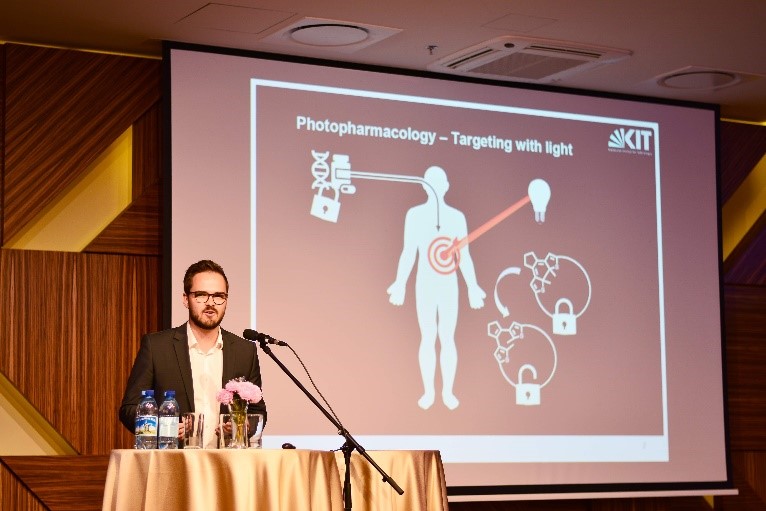Molecular Dynamics Simulations
On May 22, 2023, the Seminar Day took place at the GRK with the theme of 'Molecular Dynamics Simulations.' On this day, the members of the GRK were provided with a deeper understanding of the physicochemical background.
Dr. Tomáš Kubař expert in Theoretical Chemical Biology gave an introduction to molecular dynamics simulations to the members of the GRK, highlighting the advantages and limitations of this approach.
Following the presentation, David Hoffmann presented his research work and the progress he has made in his PhD. The exciting talk was accompanied by a practical workshop on 'Molecular Dynamic Simulations,' involving hands-on computer work using Linux. During the workshop, we were able to perform simulations ourselves, including geometry optimization of a polyalanine peptide and generating a Ramachandran plot.
We also examined a pre-simulated trajectory of the GGBP protein from Project C1, which allowed us to gain a deeper understanding of the concepts presented through practical work.
After a short break, we were joined by guest speaker Prof. Ulrich Kleinekathöfer, Professor of Theoretical Physics at Constructor University Bremen, who delivered a lecture titled 'Examples from the Computational Microscope: On Light Harvesting and Nanopores.' He effectively conveyed complex topics in a simple, engaging, and illustrative manner.
It was a highly educational and captivating day for all members of the GRK, leaving a lasting impact on their understanding of molecular dynamics simulations.
Girls’Day 2023
On April 27th, 2023, the GRK 2039 had the opportunity to give interested girls from grades 8-11 an insight into the world of chemistry and biology and to introduce them to working in a laboratory. The theme of the day was: “Let the colors shine” – Discover the secrets of biochemistry in everyday life, matching to our GRK research theme “Molecular Architectures for Fluorescent Imaging of Cells". But before the probably most exciting part of the day – the experimenting could start, there was a tour through the labs and a small introduction of the GRK members, their research, and our Research Training Group in general. To give the girls an understanding of the topics of chemistry and biology, various stations were prepared at which the girls were allowed to carry out experiments themselves in groups of two. At the first station, the students had the opportunity to isolate the genetic information (DNA) from strawberries or tomatoes. They were allowed to take the isolated DNA home as a souvenir of the Girls'Day. At the second station, they were allowed to isolate chlorophyll from spinach and explore the fluorescent properties of this green pigment found in the chloroplasts of plants. In addition, they learned about the principle of thin-layer chromatography and were able to separate chlorophyll a and b from the extracted chlorophyll. The students were also encouraged to make fluorescent bubble tea beads and pH indicator bubble tea beads which aroused great enthusiasm among the girls and awakened their spirit of research. Finally, live zebrafish embryos were examined under a microscope. The girls were also allowed to classify zebrafishs according to developmental stages based on characteristic features.
All in all, the Girls' Future Day was an all-around success for everyone involved, and a good opportunity to show the girls how to work in a lab, which may help them in their choice of career in a few years' time.
MRS Fall Conference 2022, Boston
The Material Research Science Fall Meeting features over 50 symposia and is one of the largest international materials science conference worldwide. The conference took place from the 27th November – 2nd December in Boston in the Hynes Convention Center.
For this conference, I submitted an abstract about my research and was invited for an oral presentation in the symposium SB01: Responsive Nanomaterials for Theranostics and Tissue Engineering. The aim of this symposium is to showcase the next generation of functional and responsive nanomaterials towards biomedical applications. Included topics of this symposium were nanotheranostics and nanotherapeutics as well as stimuli-responsive and adaptive nanomaterials for applications such as drug delivery and tissue engineering. I presented my latest research progress regarding the antigen-mediated spatial organization of antibody-receptor complexes that is crucial for mast cell activation. The presentation covered the synthesis and characterization of hapten-decorated DNA nanostructures, real-time binding kinetics of antibody, antigen and receptor interactions as well as cell degranulation studies.
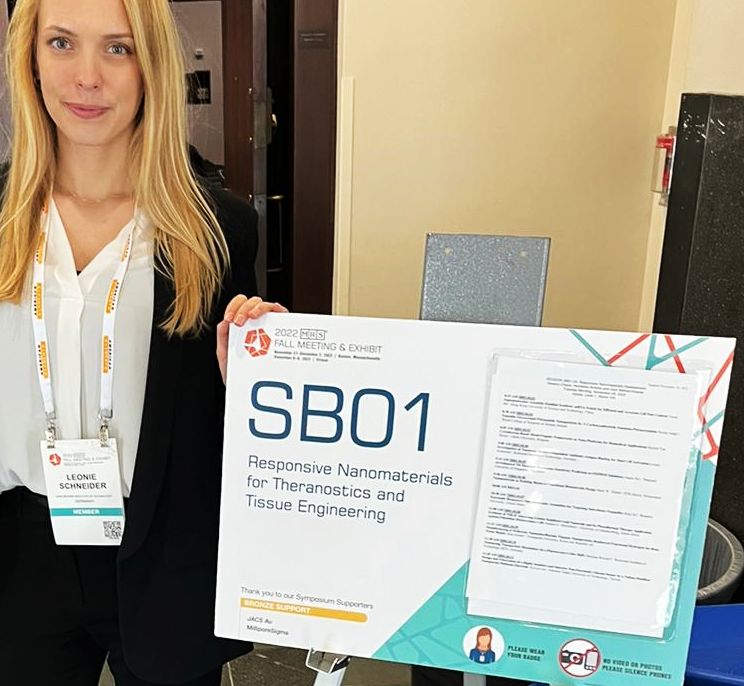 In addition to the SB01 symposium, there were many other interesting symposia and research topics with speakers that are well-known experts on their fields. Here I particularly enjoyed the great talks of Molly Stevens (Imperial College London) and Mark Tibbitt (ETH Zürich) about the broad application possibilities of biomaterials and nanoparticles. Further, Chad Mirkin (Northwestern University) held a very impressive talk about the DNA-programmable crystallization of nanoparticles into different crystal structures and Oleg Gang (Columbia University) further elaborated on this topic by using DNA origami as linker between the nanoparticles.In addition to the many inspiring talks, the conference was a great opportunity for me to present my own research to an international audience and to get in contact with other researchers from different countries and research fields for an interdisciplinary exchange at the interface of chemistry and biology.
In addition to the SB01 symposium, there were many other interesting symposia and research topics with speakers that are well-known experts on their fields. Here I particularly enjoyed the great talks of Molly Stevens (Imperial College London) and Mark Tibbitt (ETH Zürich) about the broad application possibilities of biomaterials and nanoparticles. Further, Chad Mirkin (Northwestern University) held a very impressive talk about the DNA-programmable crystallization of nanoparticles into different crystal structures and Oleg Gang (Columbia University) further elaborated on this topic by using DNA origami as linker between the nanoparticles.In addition to the many inspiring talks, the conference was a great opportunity for me to present my own research to an international audience and to get in contact with other researchers from different countries and research fields for an interdisciplinary exchange at the interface of chemistry and biology.
Sovereignty Training for Women
Before the year 2022 comes to an end, we women from the GRK had the chance to take part in a workshop to strengthen our sovereignty. A trainer from the Haufe Akademie, Ingolf von Wittken, came to KIT and together we discussed topics such as: What is sovereignty? How can we work on it? and what is the effect of a sovereign charisma? We did not only talk about the typical behaviour of men or women, but also about our goals and how we do not lose sight of the visions that make us happy. The clearer we are about who we want to be and how we want to be perceived, the clearer our communication becomes. 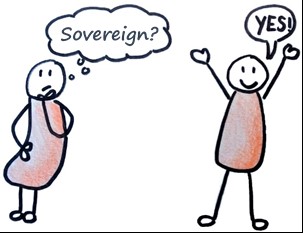 This is also why we have trained how we can influence our charisma and also our counterpart with simple tricks, without subordinating ourselves through unnecessary apologies. In this way, we can build networks and promote each other so that we can start a career. Even the smallest successes count, because if you look at the big picture at the end, every step brings us closer to our goal. We ended two exciting days of training with a variation of the "power pose" and a compliment shower. With our strengthened self-confidence and a practised elevator pitch, nothing stands in the way of a confident appearance for us women of the GRK in 2023.
This is also why we have trained how we can influence our charisma and also our counterpart with simple tricks, without subordinating ourselves through unnecessary apologies. In this way, we can build networks and promote each other so that we can start a career. Even the smallest successes count, because if you look at the big picture at the end, every step brings us closer to our goal. We ended two exciting days of training with a variation of the "power pose" and a compliment shower. With our strengthened self-confidence and a practised elevator pitch, nothing stands in the way of a confident appearance for us women of the GRK in 2023.
“Biosensors, Chips and PNA”
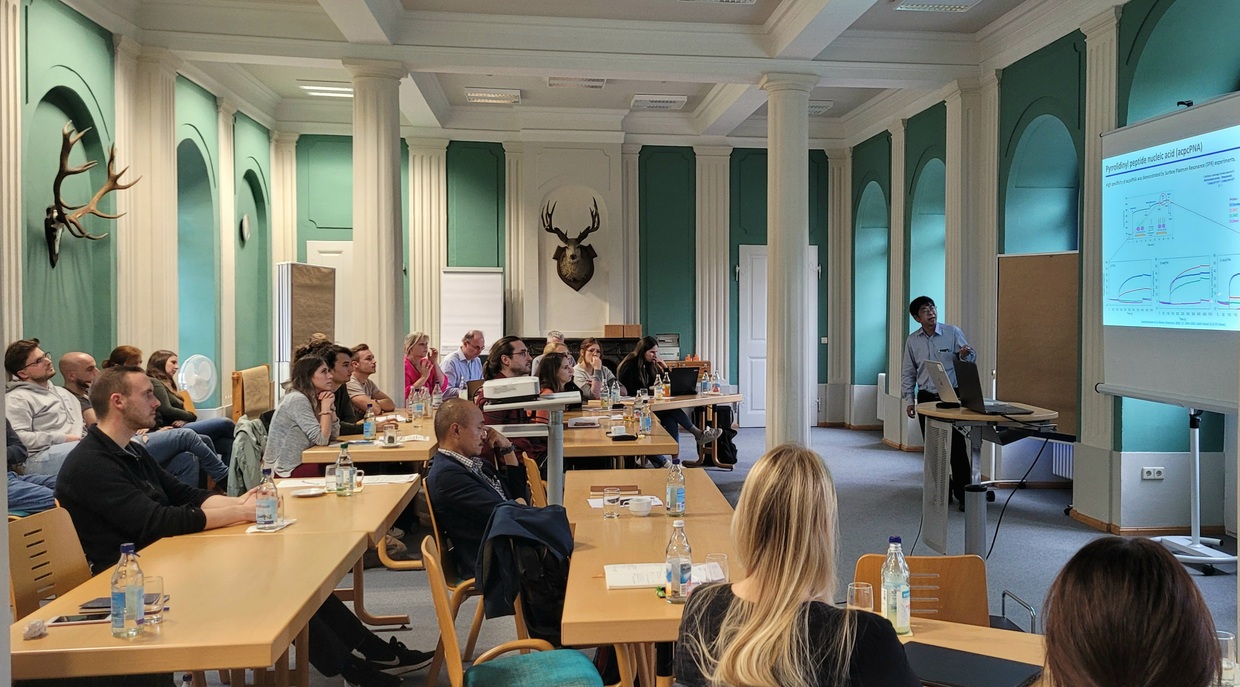
On the 18th of October the 22nd Seminar Day of the GRK about “Biosensors, Chips and PNA” took place at KIT. We had the pleasure to welcome Prof. Chittanon Buranachai, Prof. Panote Thavarungkul and Prof. Tirayut Vilaivan from Thailand as guest speakers. Due to the long journey of the Thai professors, they already explored the KIT one day before, including an excursion to Campus North, where they got to know different research areas of the KIT under the guidance of the respective professors. On the next day, after a friendly welcome by Professor Wagenknecht, the Seminar Day started with two introductory lectures of the new members of the GRK. After a tutorial under the guidance of Prof. Schepers about “Organs on Chips for the visualization of drug transport” we went into a short lunch break. Afterwards, the professors from Thailand could tell us in detail about their research, which was very interesting for all of us. The talks started with Prof. Buranachai and Prof. Thavarungkul about “DNA-based fluorescent sensors and portable fluorescence detection devices”, followed by the talk of Prof. Vilaivan about “Cationic styryl dyes for sensing and imaging of nucleic acids”. All presentations were very interesting, which is why there was a lot of discussion among the GRK members and the guest speakers after the presentations. All in all, it was an excellent Seminar Day with many new impressions and experiences. I would like to thank again the professors from Thailand for the input for our further research as well as for the nice attitude of all participants. We would be very happy to welcome them again at KIT. It was a great experience for all of us.
58th Symposium on Theoretical Chemistry (STC)
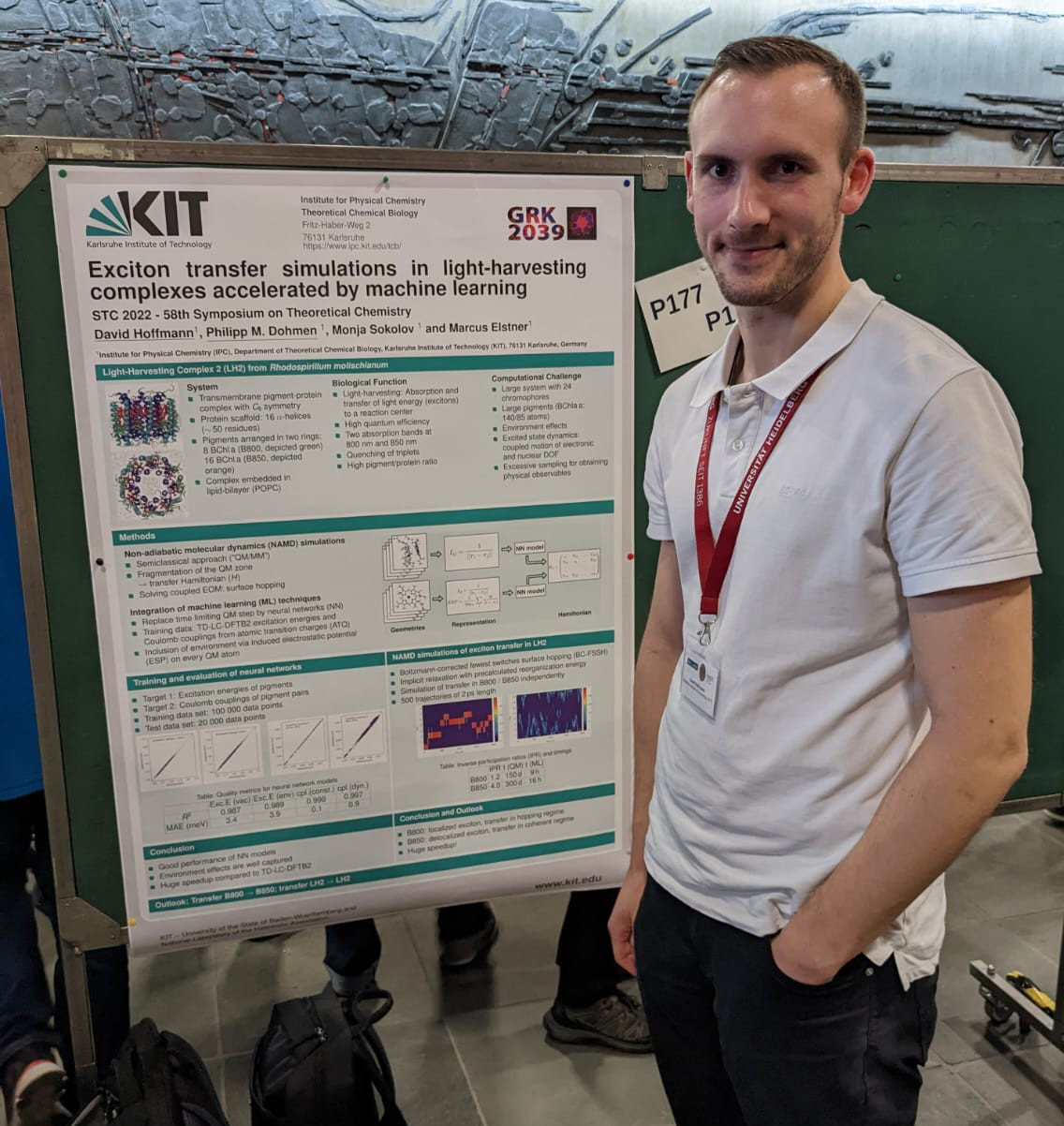 From 19th to 22th September, the 58th Symposium on Theoretical Chemistry (STC) has taken place in Heidelberg. Due to the short distance to Heidelberg, my colleagues and I decided to travel between home and the conference venue on a daily basis. The STC is the largest annual meeting of theoretical chemists and scientists from related fields in German speaking countries. This years topic of “theoretical photochemistry and spectroscopy” was particularly well aligned with my projects. Besides new advancements in theories and methods, applications to relevant chemical systems were presented in the talks and in the two poster sessions, most of which were related to the calculation of excited state properties and dynamics.
From 19th to 22th September, the 58th Symposium on Theoretical Chemistry (STC) has taken place in Heidelberg. Due to the short distance to Heidelberg, my colleagues and I decided to travel between home and the conference venue on a daily basis. The STC is the largest annual meeting of theoretical chemists and scientists from related fields in German speaking countries. This years topic of “theoretical photochemistry and spectroscopy” was particularly well aligned with my projects. Besides new advancements in theories and methods, applications to relevant chemical systems were presented in the talks and in the two poster sessions, most of which were related to the calculation of excited state properties and dynamics.
Especially the work presented by Philipp Marquetand from the University of Vienna was very inspiring. In his lecture, he showed machine learning applications to ground and excited state properties and excited state dynamics. Many talks addressed non-adaibatic molecular dynamics simulations of excited states and photochemical phenomena.
During the first poster session on Monday I had the opportunity to get in touch with PhD students from all over the world and some fruitful discussions emerged on our research. In the second poster session I was able to present a poster on my own work. This was a great opportunity to explain and discuss our approaches to interested people. Several questions stimulated me to change perspective on our own approach and to look at new interesting aspects. I could make a few connections to people working in a similar field. Despite short nights I am very glad for the experience of my first on-site conference.
8th European Chemistry Congress (ECC8)
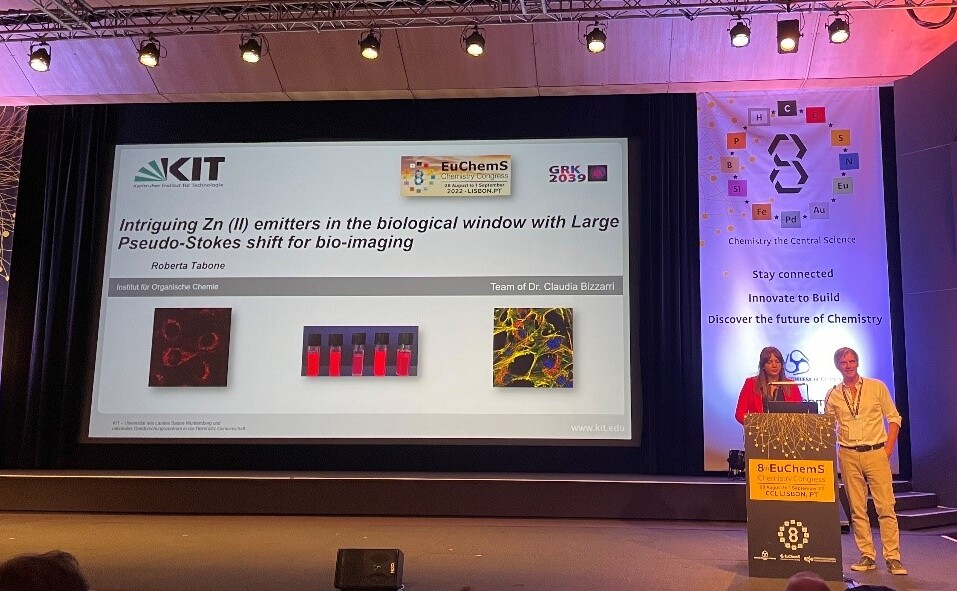
From the 28th of August until 1st of September I had the pleasure to attend the 8th EuChemS Chemistry Congress (ECC8) organized by the Portuguese Chemical Society (SPQ) and held in Lisbon, Portugal. My abstract was accepted for and oral contribution and it was amazing to present part of my PhD work on fluorescent probes for cell imaging in an enormous Auditorium in front of hundreds of people.
My talk, “Intriguing Zn (II) emitters in the biological window with Large Pseudo-Stokes shift for bio-imaging”, which was during the Imaging session, was introduced from Prof. Dr. Johan Hofkens from KU Leuven, Belgium. It was and honor for me to be presented by such an emergent professor, whose research interests several topics including also “Expansion Microscopy” and “Luminescent Materials” and of course to share the last achievements of my project.
It was a super intense week with an exciting scientific program develop around different scientific topics like “Chemistry meets Biology”, “Catalysis”, “Spectroscopic and Analytical Tools”, “Imaging” and “Functional Materials”. Over the days there were nine different session simultaneously. Obviously, it was impossible to follow them all and I gave priority to those most relevant to my topic.
It was very encouraging to listen to the Prof´s talks, from which I could draw teaching and inspiration, but it was also productive to listen to talks of other PhDs in other areas of chemistry and from all over the world.
I also had the opportunity to meet new people and of course to visit the wonderful Lisbon! Grateful for this experience and looking forward for a new one!
Edinburgh: more than a research stay
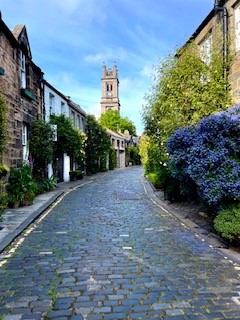 Imagine the desire to travel after two years of pandemic, aimed by the wish to discover new cultures and why not, have new input also on your research project. Despite the initial fears, arising from the unknown of a new city and habits, I am really satisfied with the choice I made. In the period from May to August, thanks to the SFC EaSI-CAT Scholarship that I won, I undertook a research stay in Edinburgh, at the EaStCHEM School of Chemistry, in the group of Professor Jason Love. During these three months I have dealt with the synthesis of catalysts, thus something different from my current research project that aims at the design of new fluorophores for cell imaging. It took some time to acquire dynamics in a new laboratory with different rules, but after a while I started learning different techniques and interfacing with new types of instruments and analysis. I was super lucky with the new colleagues there: they were nice and helpful.
Imagine the desire to travel after two years of pandemic, aimed by the wish to discover new cultures and why not, have new input also on your research project. Despite the initial fears, arising from the unknown of a new city and habits, I am really satisfied with the choice I made. In the period from May to August, thanks to the SFC EaSI-CAT Scholarship that I won, I undertook a research stay in Edinburgh, at the EaStCHEM School of Chemistry, in the group of Professor Jason Love. During these three months I have dealt with the synthesis of catalysts, thus something different from my current research project that aims at the design of new fluorophores for cell imaging. It took some time to acquire dynamics in a new laboratory with different rules, but after a while I started learning different techniques and interfacing with new types of instruments and analysis. I was super lucky with the new colleagues there: they were nice and helpful.
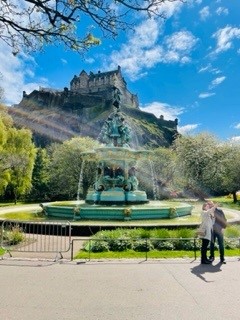 Chemistry aside, Edinburgh is a wonderful city, one of the loveliest that I have ever visited! The capital city of Scotland is a labyrinth of cobbled streets, narrow alleyways and hidden courtyards, all amazing well preserved and steeped in the city´s history. In every corner of the city you found men in kilts playing bagpipes and other folk song that animate the atmosphere. In addition, Scottish people are very inclusive and nice people with such a remarkable resistance to alcohol! Just go to a pub with them to be amazed at the amount of beer and wishy they can drink!
Chemistry aside, Edinburgh is a wonderful city, one of the loveliest that I have ever visited! The capital city of Scotland is a labyrinth of cobbled streets, narrow alleyways and hidden courtyards, all amazing well preserved and steeped in the city´s history. In every corner of the city you found men in kilts playing bagpipes and other folk song that animate the atmosphere. In addition, Scottish people are very inclusive and nice people with such a remarkable resistance to alcohol! Just go to a pub with them to be amazed at the amount of beer and wishy they can drink!
I am grateful for this wonderful experience.
Conference in Prague
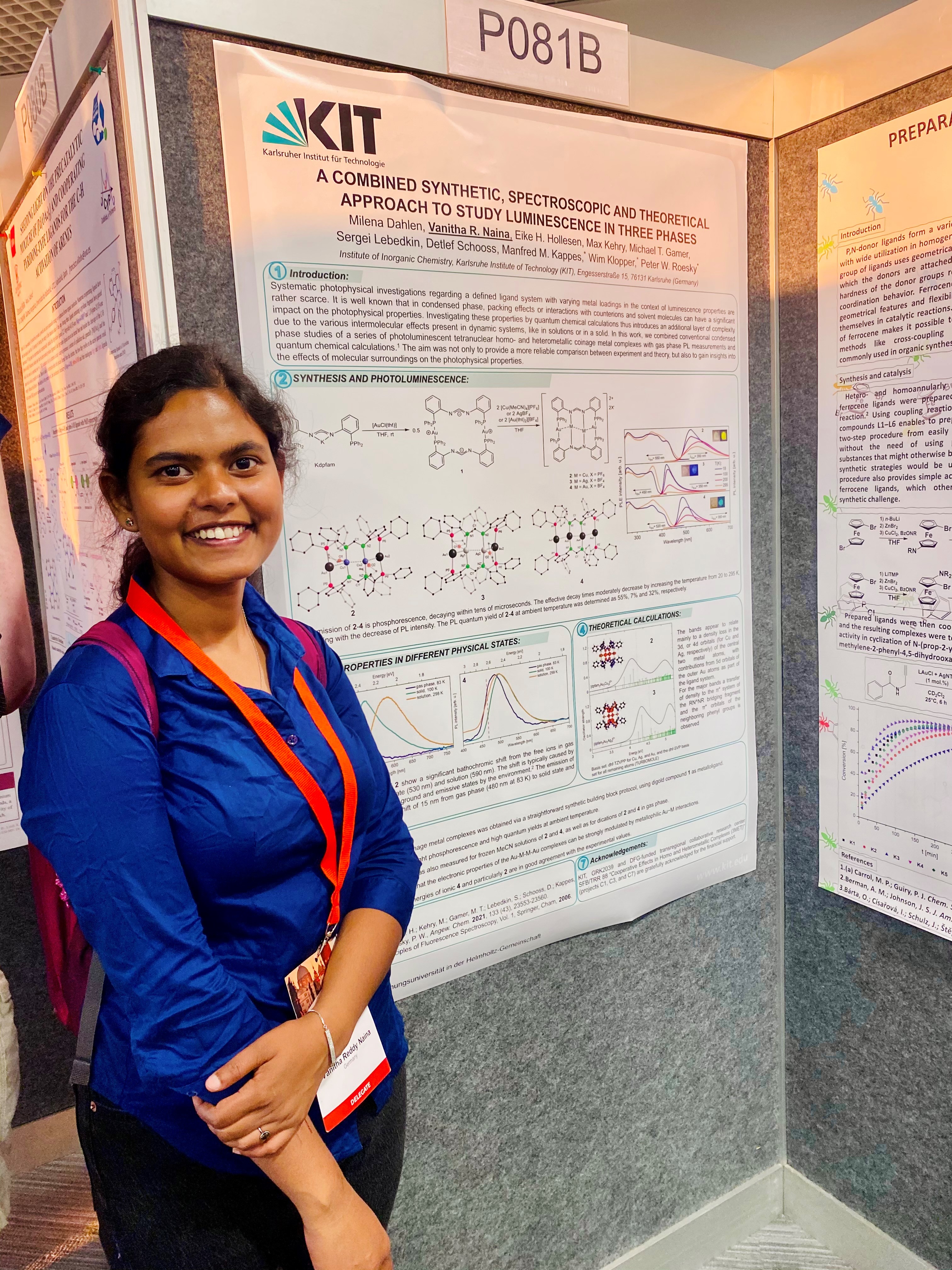 I had an opportunity to attend 29th International Conference on Organometallic Chemistry which was organized in Prague, Czech Republic from 17th-22nd July. The conference started with a welcome party on 17th July and from 18th-22nd July, the schedule was packed with several Plenary lectures, Keynote lectures, Invited lectures, Oral presentations and Poster presentations from world renowned professors, scientists and students in the field of organometallic chemistry. It was very exciting for me to learn new findings from other working groups. Personally, I was greatly inspired by the work of Prof. Guy Bertrand and Prof. F. Ekkehardt Hahn. I also had an opportunity to present a poster at the conference which was a great platform to discuss chemistry with other colleagues in Chemistry. Apart from attending lectures, I could interact with professors and other PhD students from all over the world and I am glad that I could make a few connections. Overall, attending the conference was a great opportunity to get insights into the Organometallic Chemistry and meet peers from this branch of Chemisty.
I had an opportunity to attend 29th International Conference on Organometallic Chemistry which was organized in Prague, Czech Republic from 17th-22nd July. The conference started with a welcome party on 17th July and from 18th-22nd July, the schedule was packed with several Plenary lectures, Keynote lectures, Invited lectures, Oral presentations and Poster presentations from world renowned professors, scientists and students in the field of organometallic chemistry. It was very exciting for me to learn new findings from other working groups. Personally, I was greatly inspired by the work of Prof. Guy Bertrand and Prof. F. Ekkehardt Hahn. I also had an opportunity to present a poster at the conference which was a great platform to discuss chemistry with other colleagues in Chemistry. Apart from attending lectures, I could interact with professors and other PhD students from all over the world and I am glad that I could make a few connections. Overall, attending the conference was a great opportunity to get insights into the Organometallic Chemistry and meet peers from this branch of Chemisty.
GRK2039 meets DAAD RISE
The DAAD RISE (Research Internships in Science and Engineering) program offers undergraduate students from North American, British and Irish universities the opportunity of a research internship at German universities and research institutions. To participate in this program and to offer an internship, a project description with the possible time period (between 10 weeks and 3 months are possible) has to be uploaded on the DAAD website. After this, the students can apply for the uploaded projects at the universities of their choice and rank their favoured projects. In a similar process, you can rank the applications for your project (motivation letter, CV, transcript of records) and get matched with students that prioritized your uploaded project. In my case a Bachelor student from Boston came to work with me on a project in the field of DNA-nanotechnology for 11 weeks. We developed several DNA nanostructures to study the immune response of mast cells. Here we used a lot of different methods like Atomic Force microscopy and surface plasmon resonance spectroscopy. Even though she had no prior experience of working with eukaryotic cells she did a great job and gained a lot of very good results. It was a pleasure to work with her and have an intercultural exchange. I can highly recommend participating in this program as the costs can be fully covered by the GRK or DAAD and you can help undergraduate students to gain insights into different research areas and laboratories. Further, they learn how to structure an experimental workflow, develop own ideas and how to approach and solve problems, we are all facing at one time or another in the lab.
GRK 2039 Retreat 2022
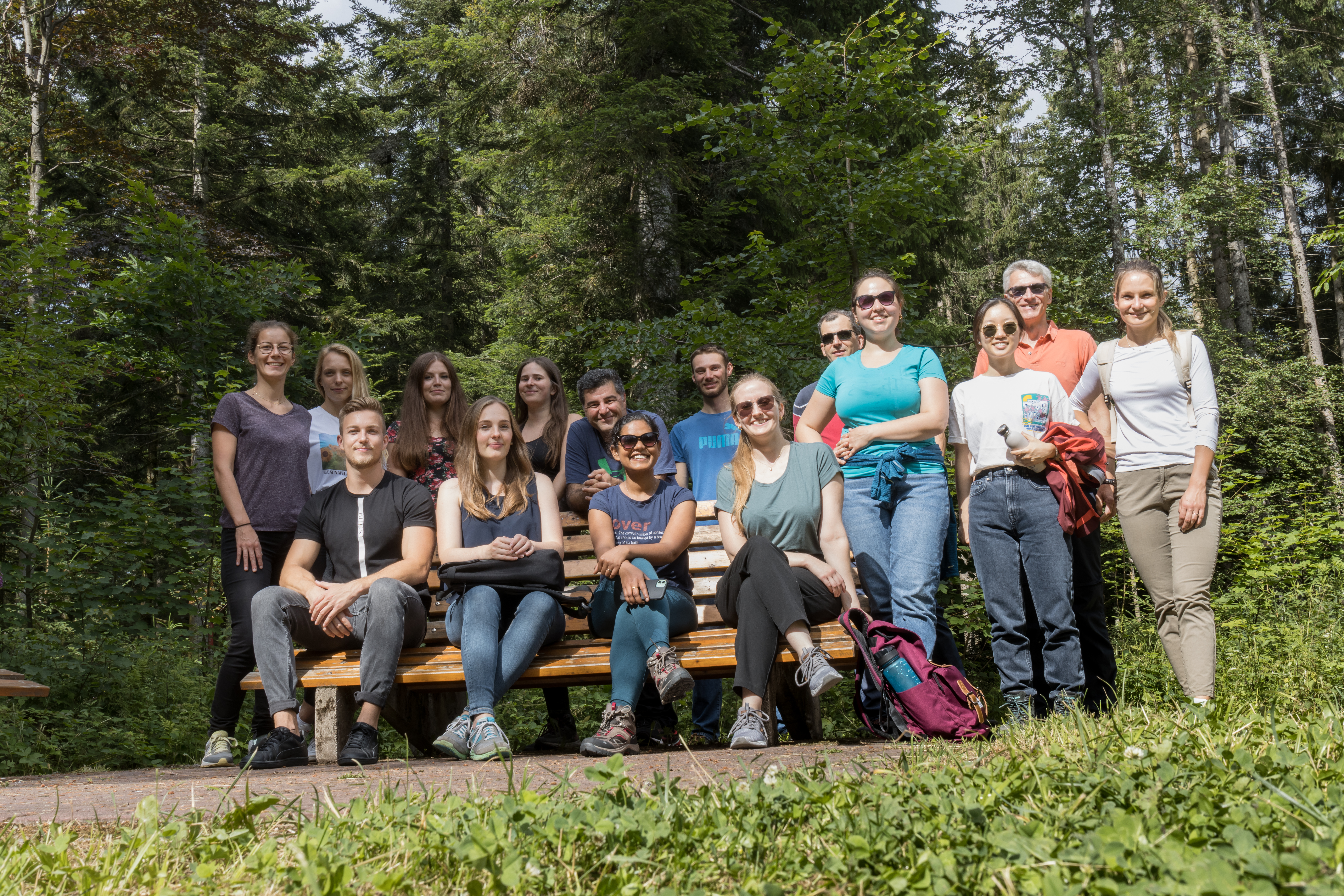 After now two years of pandemic, the GRK 2039 tries to return to its regular operation. This means, the last retreat was only seven months back until we had our actual from the 29th June to 1st July. Like usual, a few members finished their work since the last retreat to gain their PhD (congratulation!) and left the GRK. On the other side, we have some new faces in our group, who we want to welcome here.
After now two years of pandemic, the GRK 2039 tries to return to its regular operation. This means, the last retreat was only seven months back until we had our actual from the 29th June to 1st July. Like usual, a few members finished their work since the last retreat to gain their PhD (congratulation!) and left the GRK. On the other side, we have some new faces in our group, who we want to welcome here.
The first introduction talk by Prof. Wagenknecht was about the need of a strong biology in the GRK and its main goal of cell imaging. The main part of the PhD students are chemists, so to not lose the focus on the biology, some guest speakers from the biological institutes of the KIT were invited. Additional to the PhD students, who presented their latest work over the next days, we got a great overview about pure biological research and what is possible to investigate in modern cell biology. 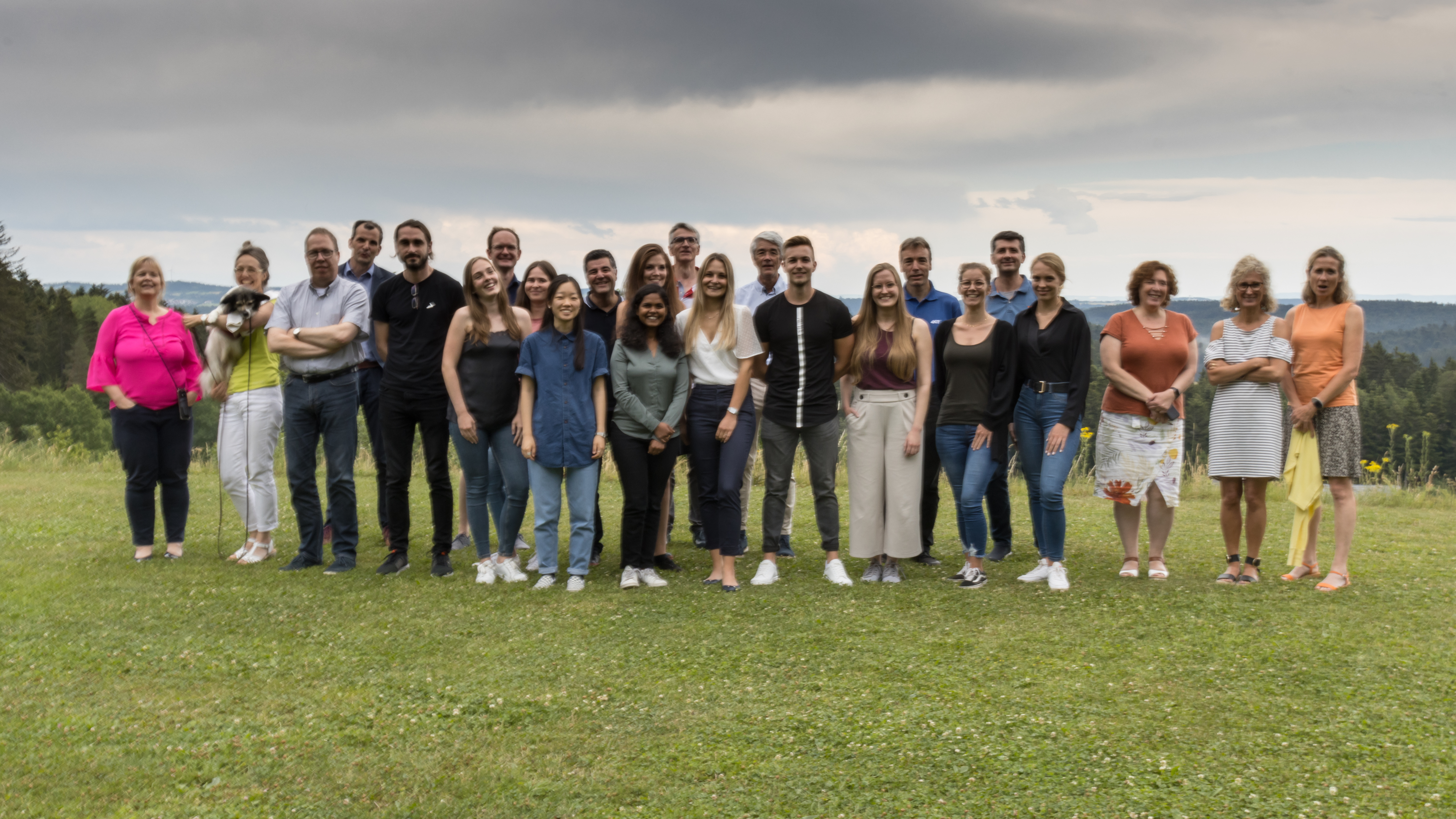
Beside the scientific part of the program, we were able to do the planned hiking trip. After the disappointing weather during the last retreat in November 2021, we were lucky to enjoy the sunshine in the black forest. Although we were missing few members due to sickness or other conditions, it was a great retreat with good organisation. Thanks to Franziska for her effort to plan it and we hope to see each other next year.
Biochemistry Meeting 2022 in Muenster
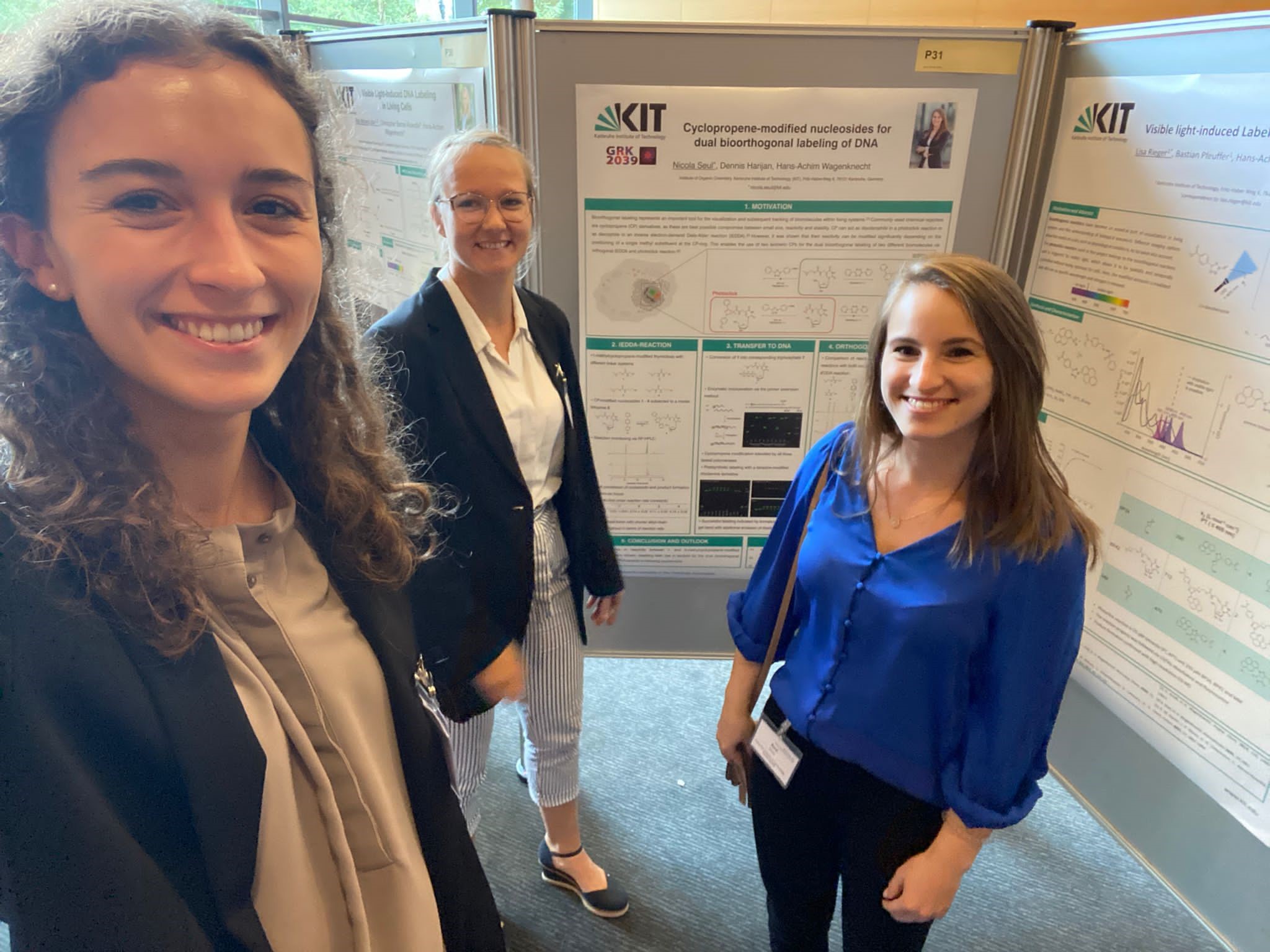 From the 29th of June until the 1st of July I had the opportunity to participate in the `Biochemistry 2022’ Conference in Muenster. The meeting is hosted by the GDCh and intents to bring together all scientists working in different areas of chemical biology such as the (semi)-synthesis or modification of proteins and nucleic acids or new analytical tools. Over the course of three days we heard approximately 30 talks from different researchers ranging from senior professors to PhD students. For me as a PhD student it was a great opportunity to get insights into the current trends and directions in the field in particular concerning the labeling of nucleic acids. Personally, I found the talk of Ulla Gerling-Driessen from the University of Duesseldorf especially interesting. She presented the design of a bioorthogonal handle which comprised multiple analytical tools such as a fluorophore for imaging, an isotopic label for mass spectrometry and affinity tag for improved purification. Aside from the scientific program I was able to meet and exchange with PhD students from all over Germany and Austria which was really nice and motivating.
From the 29th of June until the 1st of July I had the opportunity to participate in the `Biochemistry 2022’ Conference in Muenster. The meeting is hosted by the GDCh and intents to bring together all scientists working in different areas of chemical biology such as the (semi)-synthesis or modification of proteins and nucleic acids or new analytical tools. Over the course of three days we heard approximately 30 talks from different researchers ranging from senior professors to PhD students. For me as a PhD student it was a great opportunity to get insights into the current trends and directions in the field in particular concerning the labeling of nucleic acids. Personally, I found the talk of Ulla Gerling-Driessen from the University of Duesseldorf especially interesting. She presented the design of a bioorthogonal handle which comprised multiple analytical tools such as a fluorophore for imaging, an isotopic label for mass spectrometry and affinity tag for improved purification. Aside from the scientific program I was able to meet and exchange with PhD students from all over Germany and Austria which was really nice and motivating.
Time Resolved Spectroscopy - Seminar Day
On the 30th of May we had a seminar day about time resolved spectroscopy that started with a very interesting talk from Prof. Andreas Unterreiner and one of his PhD students Pascal Raute. After we learned about some theoretical backgrounds as well as ongoing GRK projects involving time-resolved spectroscopy, we had a very interactive practical part, where we could have a look on the equipment and had an instrumental briefing. The experimental set-up was very impressive and the fine adjustment of mirrors to direct the laser path accurately was challenging and required a lot of sensitivity. But with the necessary support from our experts Prof. Unterreiner and Pascal, we were able to successfully carry out a measurement and have a look on the measured data. Following the laboratory tour, the day was finished with a very interesting guest talk from Prof. Eberhard Riedle (LMU, Chair of Experimental Physics - BioMolecular Optics) and a “Talk to the speaker” session where we were able to address questions and have deeper discussions while having a snack.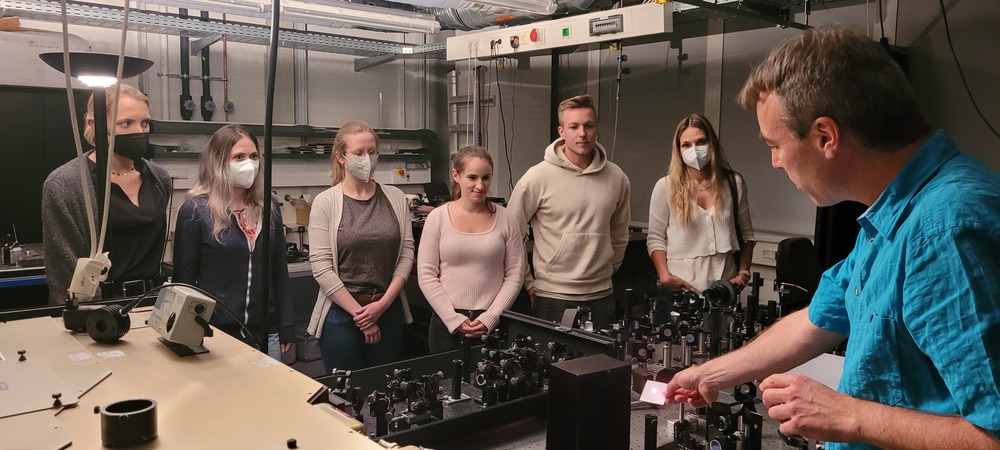
GRK 2039 Retreat 2021
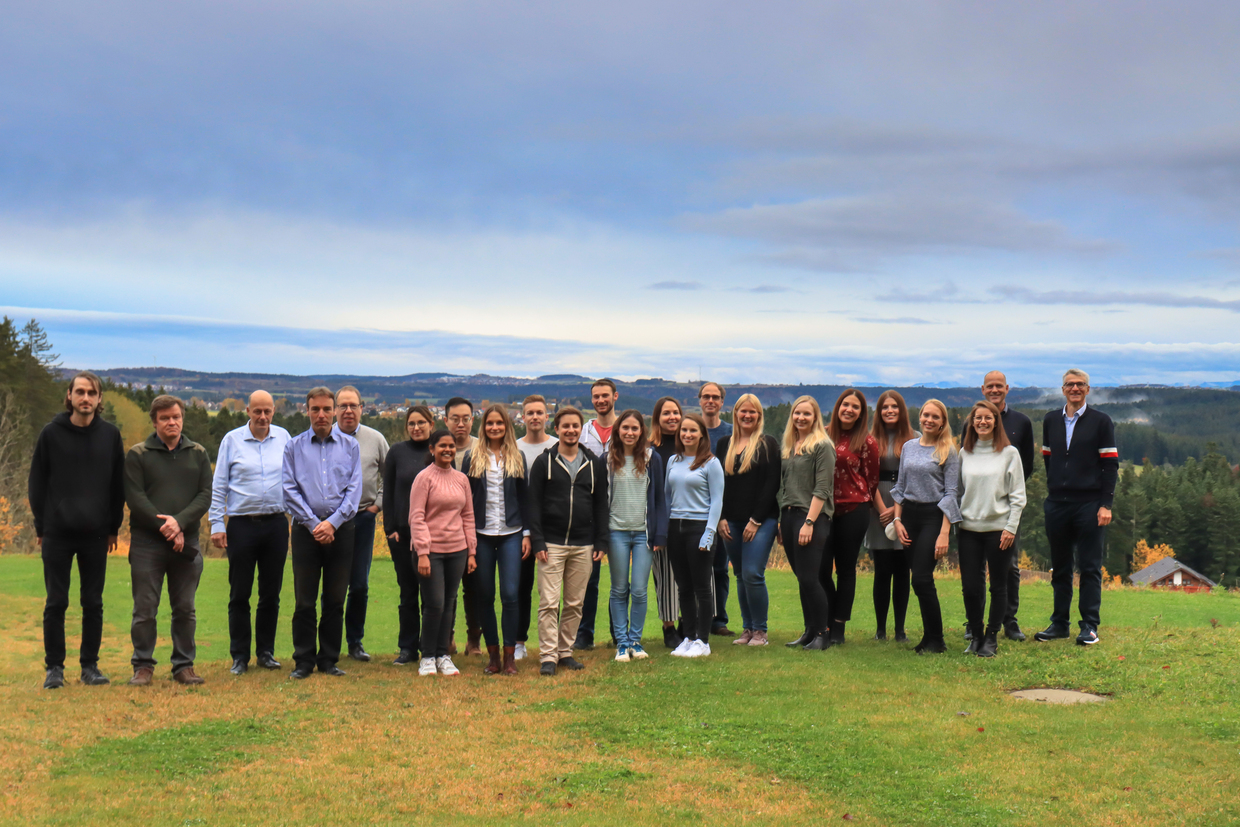
GRK-Retreat 3rd - 5th November 2021
After a 20 month gap to the last retreat in march 2020, it was finally possible to meet again in Lauterbad for three days of presenting, bonding and communicating. The program started with a short introduction from Prof. Wagenknecht. In the next three days, everybody showed his/her latest success, what new compounds were synthesized, photophysical investigations up to the application in living organisms. Thanks to the modern technology, even the students who join physically, could present their latest results via zoom. The poster-sessions on Wednesday evening was a well-used occasion for starting new cooperations inside the GRK.
After the last presentation, the doctoral researchers had time to discuss further plans about the GRK program and found new students’ representatives. Thanks to Gloria and Dominik for fulfilling that function and welcome to Roberta and Bastian as our new representatives. We are look forward for the next retreat in June, hopefully with more sunshine.
GRK 2039 Retreat 2020
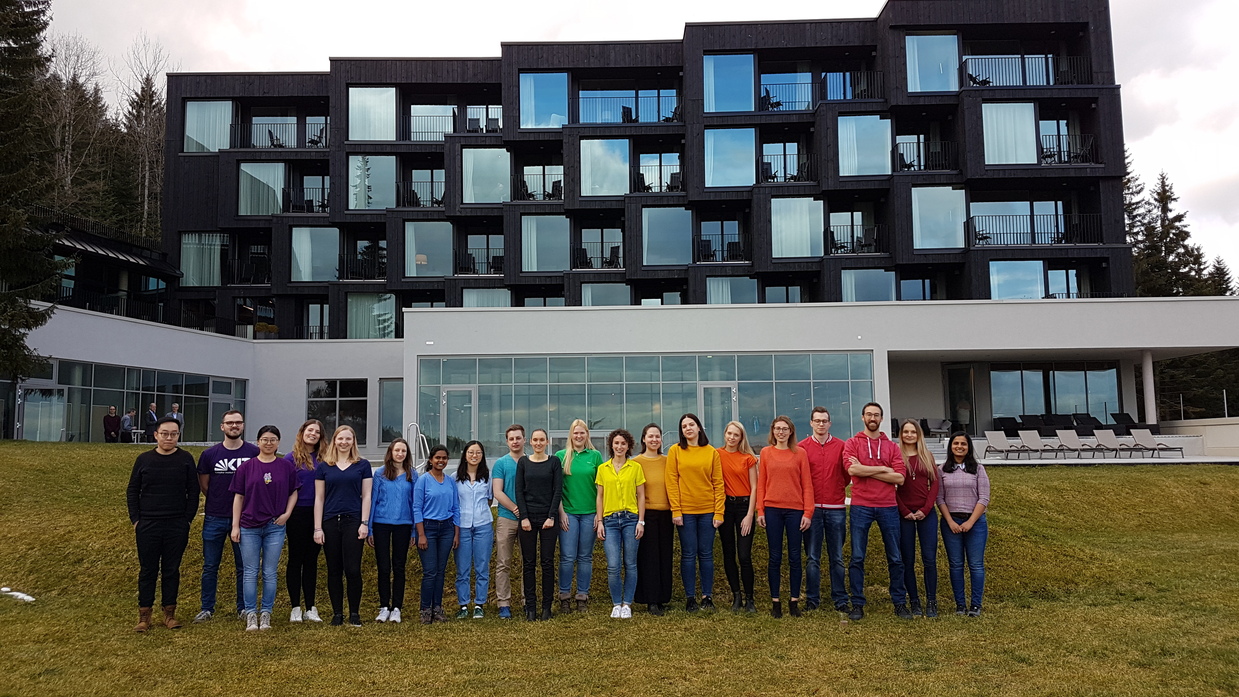
* Annual GRK 2039 retreat 2019
From the 3rd to the 5th of June the annual GRK 2039 retreat took place in Lauterbad in the Black Forest. Like last year, the participating GRK members resided in the well- known Waldhotel Zollernblick, which is currently under construction and granted us not only a view of the Black Forest but also of a new pool.
The program for all three days mainly consisted of project presentations by the GRK members and three interesting tutorials, given by Prof. Roesky, Dr. Unterreiner and Dr. Ruben Ragg from Wiley. Dr. Ragg provided us with an astonishing insight into the job of a publisher.
After everybody enjoyed dinner at the hotel, the highlight of the first day was the poster session, in which each GRK member presented their project on a poster. Active discussions and newly formed co-operations were the result of this session. Afterwards a few members concluded the first evening in the newly built Bar area of the hotel.
As a team event all participants went on a four- hour hike in the afternoon of the second day. First the hike led us to a bird tower with the attempt of taking a new GRK 2039 group picture. The hike was then crowned by a dinner in the Friedrichs am Kienberg and a short 30 minute walk back to the hotel. Once more the evening was ended with a relaxing get together on the terrace of the hotel with a lovely view of the Black Forest.
Thanks to Sahana for planning and organization of the schedule and to Franziska for organization of the trip.
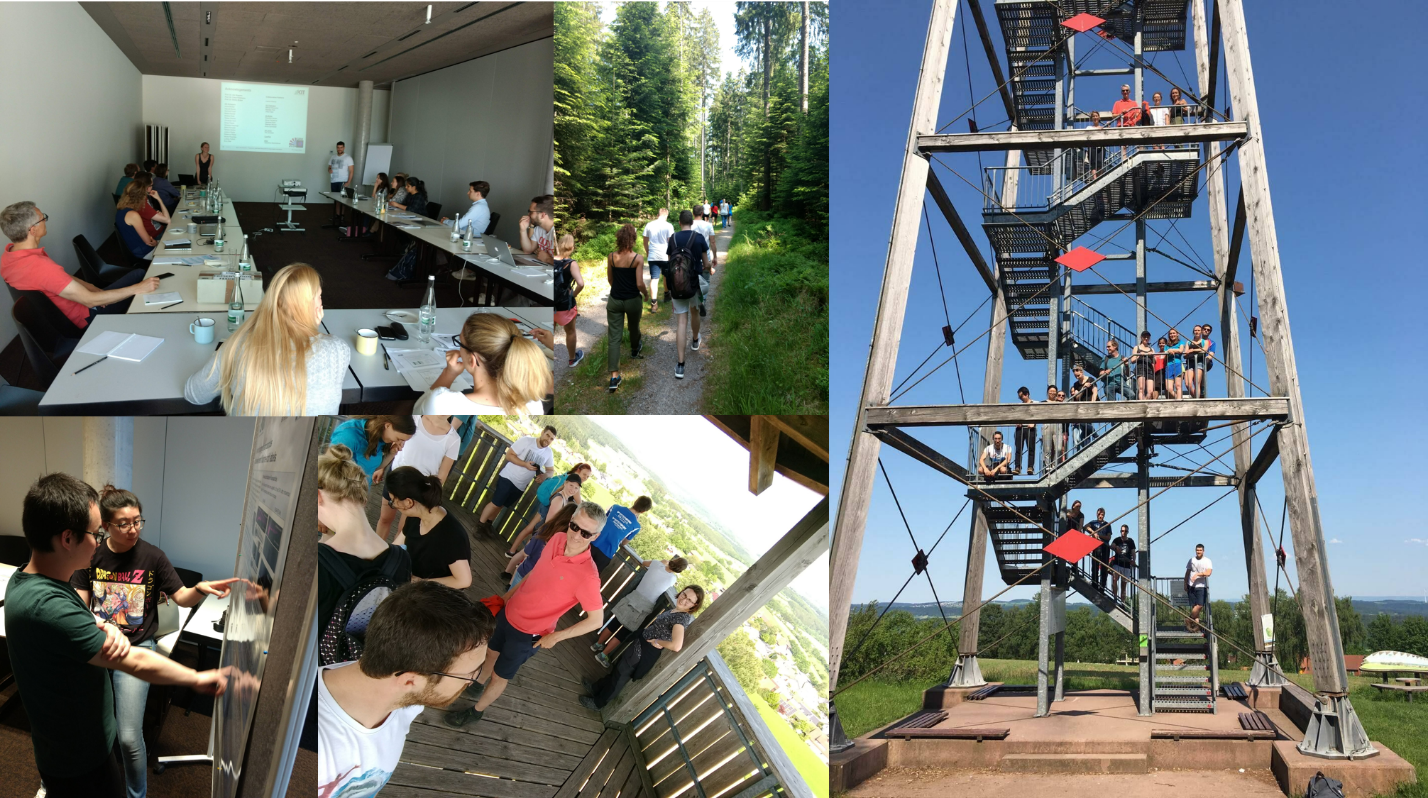
* Berlin: 16. European Short Course on Time-resolved Fluorescence Spectroscopy
Vom 04. – 08. November fand in Berlin der jährliche Kurs zur zeitaufgelösten Fluoreszenzspektroskopie von der Firma PicoQuant statt. Wir waren 40 Teilnehmer und rund 15 Sprecher und Trainer. Am ersten Tag wurde nach einer netten Begrüßung unter anderem von Joseph R. Lakowicz und Zygmunt „Karol“ Gryczynski eine allgemeine Einführung in das Thema der Fluoreszenz gegeben.
In den darauffolgenden Tagen wurden generelle und instrumentelle Einweisungen zum Thema zeitaufgelöstes Einzelphotonenzählen (TCSPC), sowie der dazugehörigen Datenanalyse gegeben.
Die theoretischen Einheiten wurden von mehreren praktischen Sessions begleitet. Hier wurden wir in kleine Gruppen eingeteilt und konnten selbst Messungen durchführen. In den verschiedenen Stationen wurden an den jeweiligen Geräten zeitaufgelöste und stationäre Fluoreszenzspektren, TCSPC, Anisotropie und Mikroskopie gemessen. Eine weitere Station war die Datenanalyse, wobei hier die Analyse von den genannten Messungen erläutert und Hilfestellungen dazu gegeben wurden.
Joe und Karol beantworten allen Fragen der Teilnehmer, halfen bei instrumentellen Schwierigkeiten und gaben weitere Tipps für die jeweiligen Messungen.
Es war ein toller und vor allem lehrreicher Kurs.
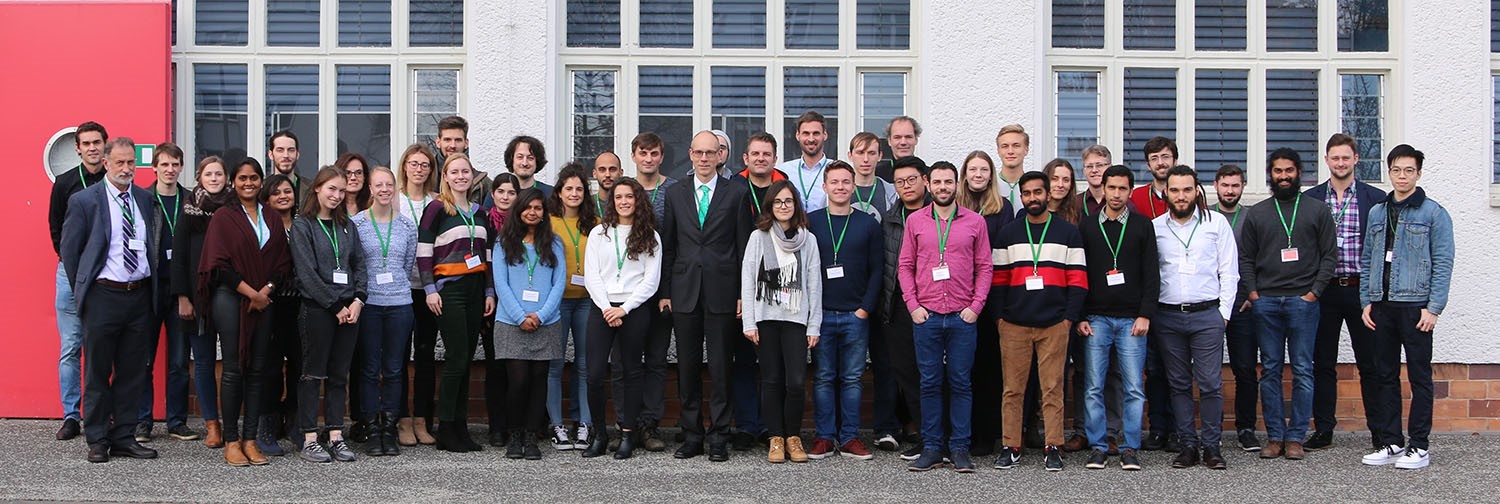
* What`s the trick behind effective visual communication?
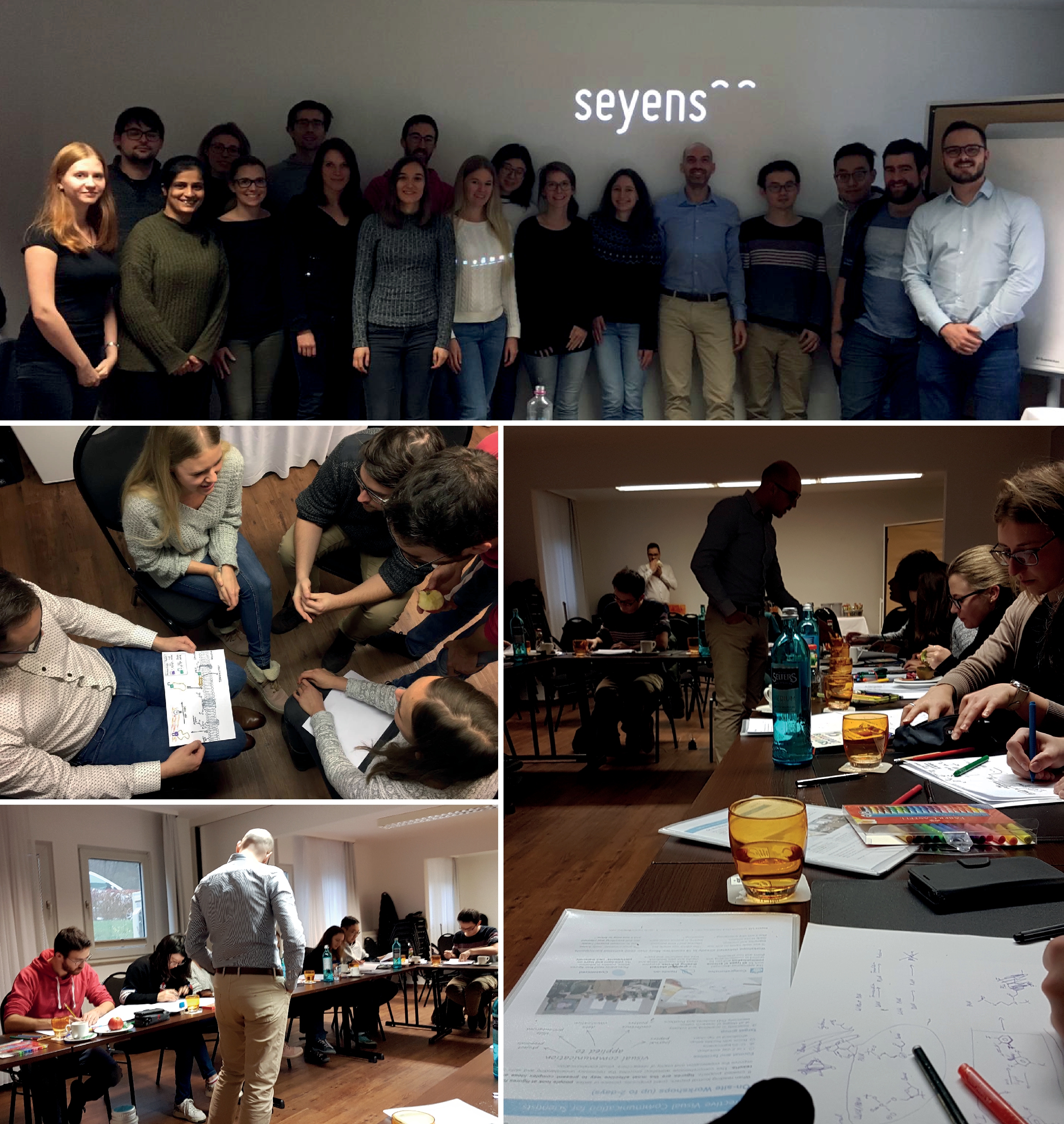
On the 19th and 20th November the PhD members of the GRK-group had an opportunity to participate in a training course for efficient visual communication, given by Dr. Jernej Zupanc (Seyens Ltd.; www.seyens.com). The special focus of this course was on developing and structuring of scientific illustrations in order to make them more descriptive and appealing. The participants had to learn how to address different groups of interest, how complex graphic correlations can be simplified and which colour composition should be used in the illustrations to avoid disorientation and confusion of the observers. Moreover, typical examples of application were discussed in detail, based on self-made illustrations for journal publications as well as for poster or oral presentations of the participants.
A highlight of the training event and at the same time the biggest challenge for the PhD students was a task where everyone had to develop a drawing which would explain his or her research project without any oral comments. In a subsequent discussion in small groups the illustrator was first not allowed to comment his own drawing whilst the others had to interpret it. Thus, deficiencies of the individual graphic illustrations became obvious and were easily mended in teamwork.
Besides the course itself, the participating GRK members spent a pleasant get-together evening enjoying cultural and culinary attractions of Schwetzingen, where this two-day event took place.
Overall, the time in Schwetzingen was very exciting and informative for everyone. Follow our research and you will probably notice soon how the graphics and illustrations get better and better – thanks to Dr. Jernej Zupanc!
* Merry Christmas and a Happy New Year!
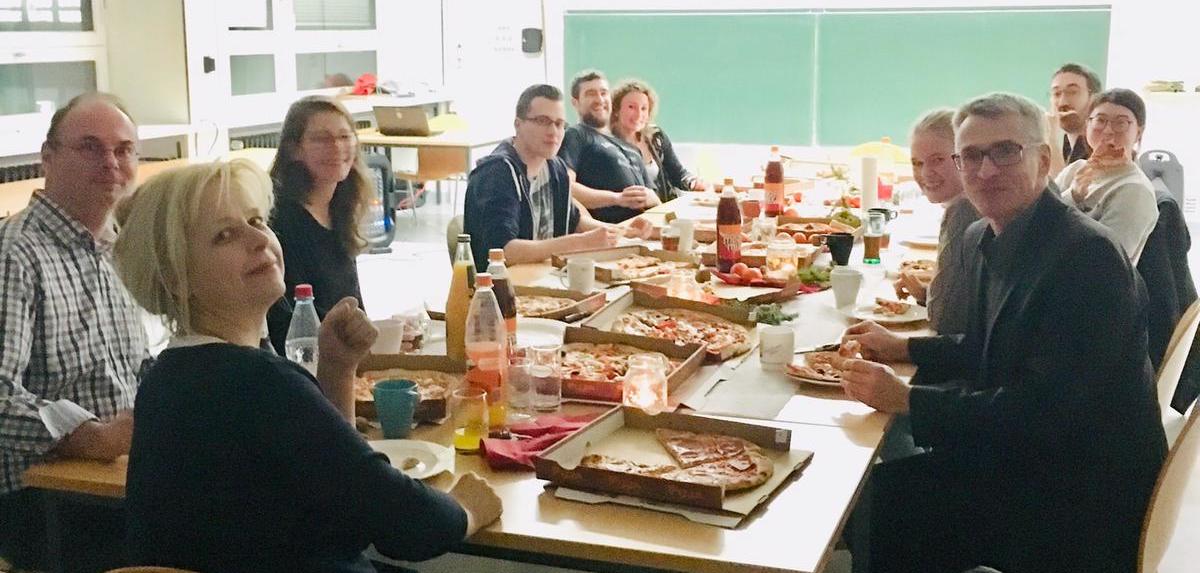 Thank you Tim for organizing our GRK christmas party! It was a very nice to meet before the holidays.
Thank you Tim for organizing our GRK christmas party! It was a very nice to meet before the holidays.
I wish you all a Merry Christmas and a good start into the year 2019!
* Besser argumentieren für Frauen
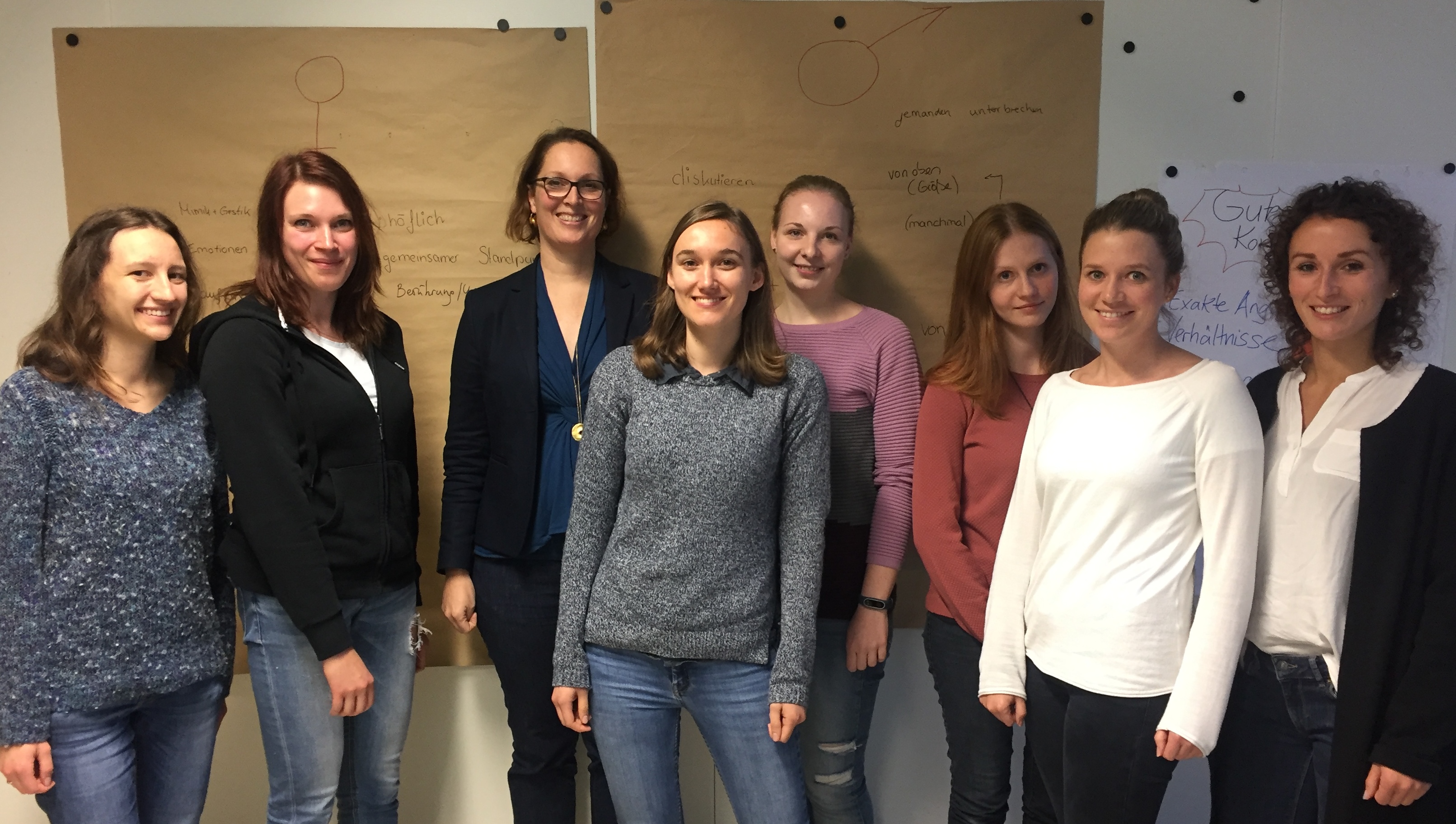
* Prof. Dr. Jacqueline K. Barton
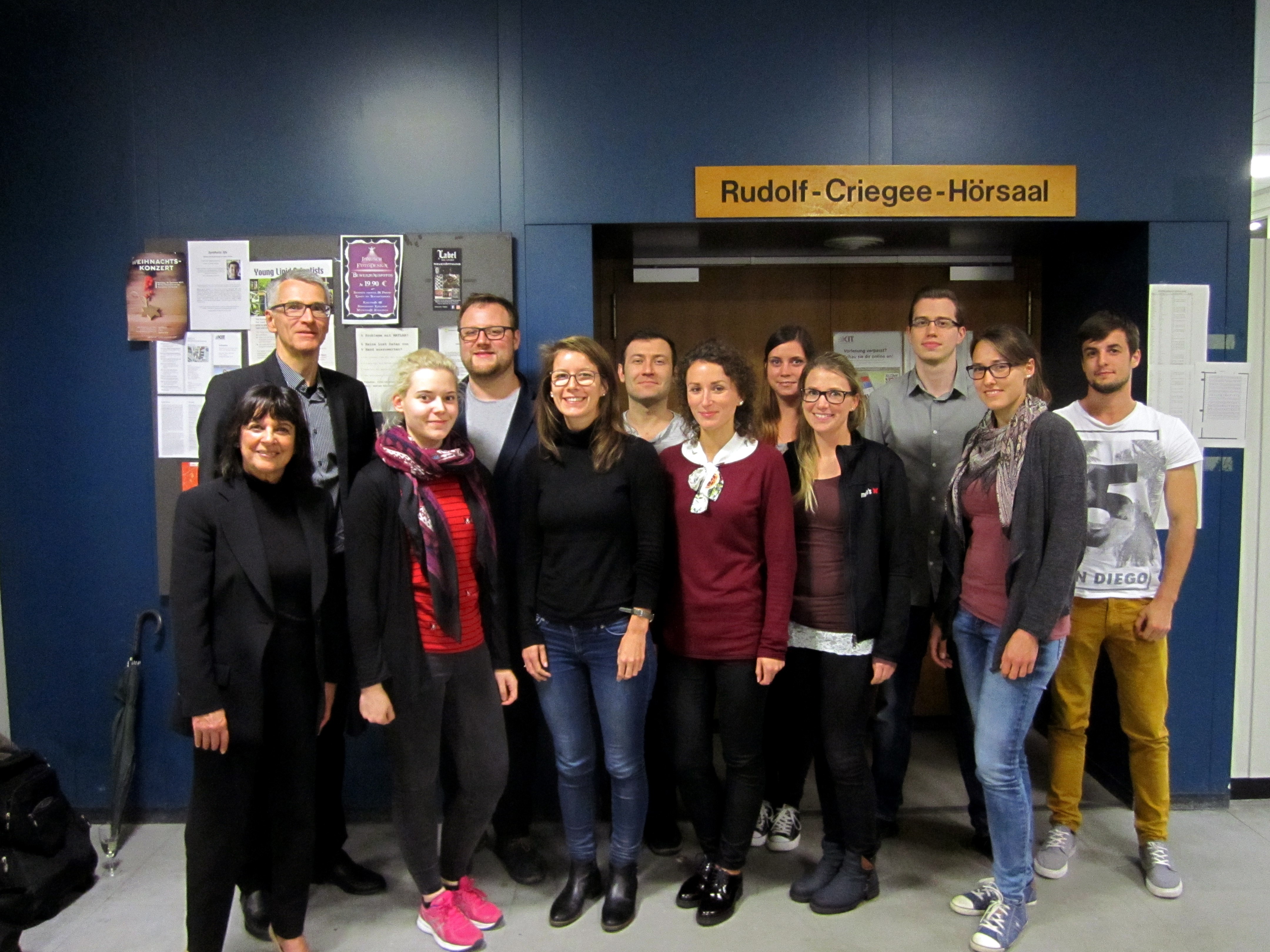 On October 23rd we had the pleasure to welcome Prof. Jaqueline K. Barton from the California Institute of Technology (Caltech), USA as the guestspeaker for the 15th Criegee-Lecture “DNA Signaling”. Prof. Barton is one of the world’s leading nucleic acid chemists, awarded e.g. with the National Medal of Science (2011) and the Prestley Medal (2015).
On October 23rd we had the pleasure to welcome Prof. Jaqueline K. Barton from the California Institute of Technology (Caltech), USA as the guestspeaker for the 15th Criegee-Lecture “DNA Signaling”. Prof. Barton is one of the world’s leading nucleic acid chemists, awarded e.g. with the National Medal of Science (2011) and the Prestley Medal (2015).* Nacht der Wissenschaften am KIT –Jagd auf die schnellsten chemischen Reaktionen
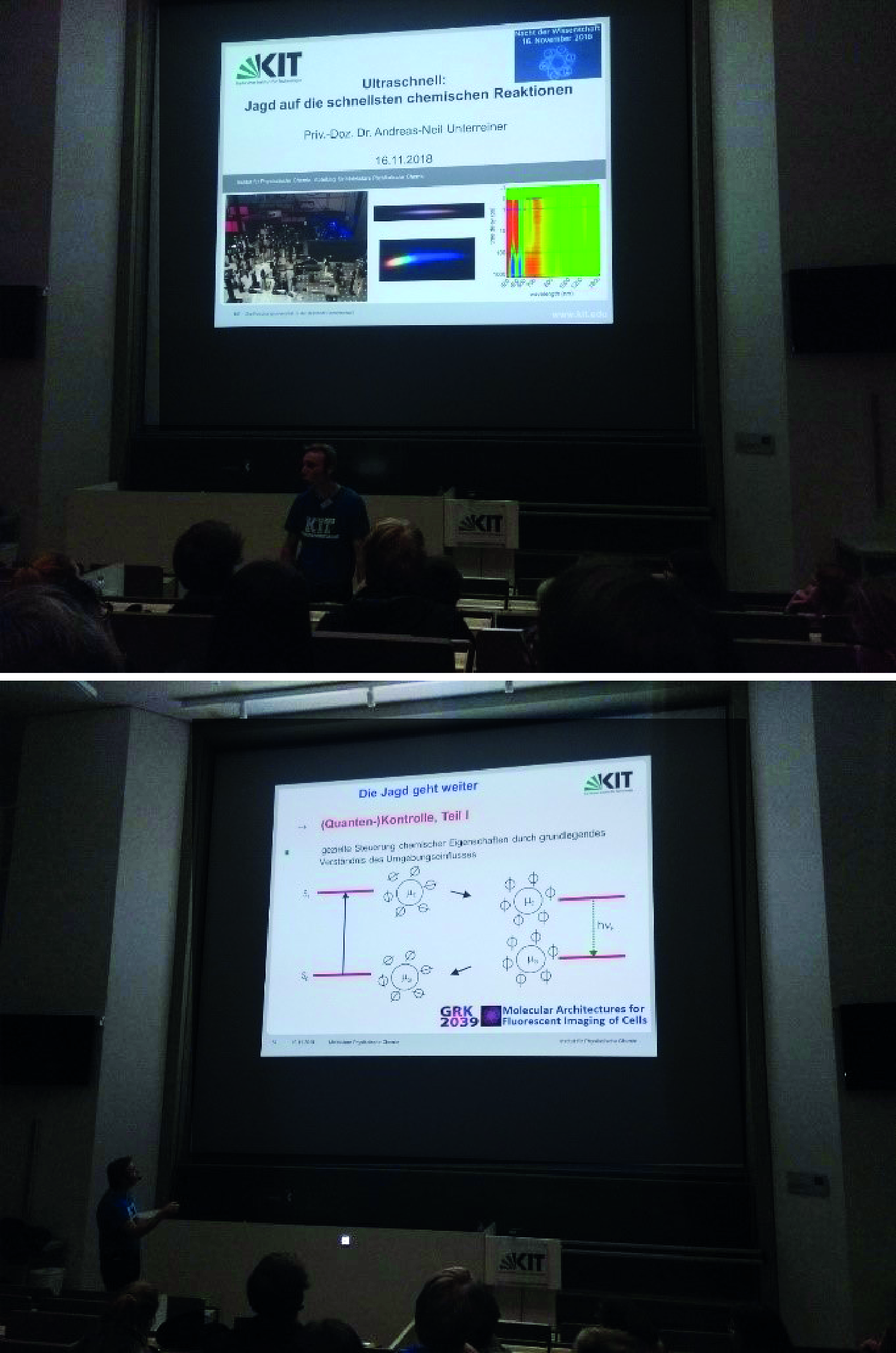 Am 16.11.2018 führte Priv.-Doz. Dr. Andreas-Neil Unterreiner bei der Nacht der Wissenschaften des KITs mit seinem
Am 16.11.2018 führte Priv.-Doz. Dr. Andreas-Neil Unterreiner bei der Nacht der Wissenschaften des KITs mit seinem  Vortrag „Ultraschnell – Jagd auf die schnellsten chemischen Reaktionen“ in die Welt ultraschneller Bewegungen und Reaktionen von Molekülen ein. Er begeisterte die zahlreichen Besucher von jung bis alt im voll besetzten Tulla-Hörsaal mit vielen spannenden Fragen, welchen er in interessanten Beispielen und sportlichen Einlagen auf den Grund ging: Was ist überhaupt schnell, oder gar ultraschnell? Ist die menschliche Reaktionszeit bereits schnell? Zum Beispiel beim Versuch den Klaviertastenanschlag-Rekord zu brechen (13,73 Hz). In Relation zu den vorausgehenden Prozess-Kaskaden, die zu einer menschlichen Reaktion führen, ist die Antwort nein. Zum Beispiel spielt sich die cis-/trans-Isomerisierung von Retinal als Startschuss des Sehprozesses auf einer (ultra-)kurzen Zeitskala von einigen hundert Femtosekunden (1 fs = 10-15 s) ab. Durch die induktive Herangehensweise von Priv.-Doz. Dr. Unterreiner war es dem Publikum möglich, auch komplexen Zusammenhängen einfach zu folgen und einen Eindruck für Zeitskalen von Translations-, Rotations- und Schwingungsbewegungen von Molekülen und deren Reaktionen zu gewinnen. Daran anschließend stellte Priv.-Doz. Dr. Unterreiner einen Bezug zu aktuellen Themen der Grundlagenforschung her. Zum Beispiel werden photophysikalische Fragestellungen im Rahmen des Projektbereichs M2 im GRK 2039 zu Molekülen für die fluoreszente Bildgebung von Zellen mittels zeitaufgelöster fs-Spektroskopie untersucht. Zusammengefasst gab Priv.-Doz. Dr. Unterreiner einen sehr spannenden und informativen Vortrag, der Wissenschaftlern wie Nicht-Wissenschaftlern einen Einblick in die schnellsten Molekülbewegungen, die das Schicksal einer jeden chemischen Reaktion bestimmen, ermöglichte.
Vortrag „Ultraschnell – Jagd auf die schnellsten chemischen Reaktionen“ in die Welt ultraschneller Bewegungen und Reaktionen von Molekülen ein. Er begeisterte die zahlreichen Besucher von jung bis alt im voll besetzten Tulla-Hörsaal mit vielen spannenden Fragen, welchen er in interessanten Beispielen und sportlichen Einlagen auf den Grund ging: Was ist überhaupt schnell, oder gar ultraschnell? Ist die menschliche Reaktionszeit bereits schnell? Zum Beispiel beim Versuch den Klaviertastenanschlag-Rekord zu brechen (13,73 Hz). In Relation zu den vorausgehenden Prozess-Kaskaden, die zu einer menschlichen Reaktion führen, ist die Antwort nein. Zum Beispiel spielt sich die cis-/trans-Isomerisierung von Retinal als Startschuss des Sehprozesses auf einer (ultra-)kurzen Zeitskala von einigen hundert Femtosekunden (1 fs = 10-15 s) ab. Durch die induktive Herangehensweise von Priv.-Doz. Dr. Unterreiner war es dem Publikum möglich, auch komplexen Zusammenhängen einfach zu folgen und einen Eindruck für Zeitskalen von Translations-, Rotations- und Schwingungsbewegungen von Molekülen und deren Reaktionen zu gewinnen. Daran anschließend stellte Priv.-Doz. Dr. Unterreiner einen Bezug zu aktuellen Themen der Grundlagenforschung her. Zum Beispiel werden photophysikalische Fragestellungen im Rahmen des Projektbereichs M2 im GRK 2039 zu Molekülen für die fluoreszente Bildgebung von Zellen mittels zeitaufgelöster fs-Spektroskopie untersucht. Zusammengefasst gab Priv.-Doz. Dr. Unterreiner einen sehr spannenden und informativen Vortrag, der Wissenschaftlern wie Nicht-Wissenschaftlern einen Einblick in die schnellsten Molekülbewegungen, die das Schicksal einer jeden chemischen Reaktion bestimmen, ermöglichte.* Efficiently Photocontrollable or not? Biological Activity of Photoisomerizable Diarylethenes
I. V. Komarov, S. Afonin, O. Babii, T. Schober, A. S. Ulrich, Chem. Eur. J. 2018, 24, 1–11.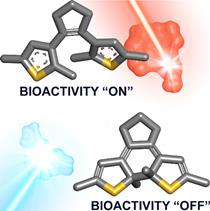
For the fundamental understanding of biological processes and systems, experimental scientists utilize various controlling tools – to perturb biological systems and generate reciprocal knowledge by analyzing biological response. Such knowledge is useful, for example, for comprehending mechanisms of human diseases. At the same time, practicing the biosystem perturbation allows developing effective modulators that serve as treatments or diagnostic tools. Recently non-ionizing light has emerged as an exciting way of imposing biocontrol, non-invasively and orthogonally to most bioprocesses. Medical utility of light as the controlling principle is explored in the fields of optogenetics and photopharmacology. Both disciplines make use of molecular photoswitches to transmit the light signal. Their use also permits an unprecedented spatiotemporal control through the external light application with modern miniature light sources and light guides, resulting in activation/deactivation of such photoswitchable modulators at will only where their action is required. In our recent concept paper, we discuss the use of so-called diarylethenes – a novel class of molecular photoswitches broadly applied in technical applications, but underexplored for in vivo biocontrol. Unlike commonly known and vastly applied azobenzenes, diarylethenes upon photoswitching do not undergo dramatic conformational changes. Instead, they switch between rigid and very flexible photophorms, therefore their structure-function relationships are more complex. Notably, the rigid form can be switched to the flexible form with red light, which makes diarylethene-based photoswitches attractive for applications in living organisms. We analyze current scarce in number examples of diarylethene-mediated biocontrol and define types of processes or biosystems where this rigidity/flexibility interplay can lead to beneficial usages.
* Frontiers in Delivery of Therapeutics
* Impressions about the microfluidics conference in Heidelberg
I recently participated in a three-day microfluidics conference at Heidelberg, Germany. The conference titled “Microfluidics 2018: New Technologies and Applications in Biology, Biochemistry and Single-Cell Analysis” is one of the biggest conferences in Europe organized by EMBL (European Molecular Biology Laboratory) focusing on current state-of-the art in the field of microfluidics and its applications in Molecular Biology. This was my first conference as a PhD student and I could not have asked for more. It was a great opportunity for an early researcher like me to get insights into the current trends and directions in the field of microfluidics, given that my doctoral studies involves microfluidic applications in the field of chemical biology.
Prior to the conference, I kept myself informed with the general information on the relevant lectures and keynote speakers. I was very impressed with the structuring and contents of the topics covered in the conference. The gathering was an amalgamation of some of the pioneer research groups in the field of microfluidics.
The conference hall at the EMBL center Heidelberg, the ARC Auditorium was fascinating in terms of its construction, perfectly designed for the scientific conferences. Particularly astonishing was the architecture of the hall way inspired by DNA double helix, through which the posters were aligned. The educational and product based stalls present there were from various companies, institutions and start up’s. The conference was attended by close to 200 people and one could say the gathering was quite international. The topics covered during conference were categorized into several segments covering sub topics. The poster sessions were distributed between two days and the large student gathering created a very vibrant atmosphere. The first lecture was delivered by Prof. Stephen Quake from Stanford, who provided a solid start to the conference through his engaging presentation about single cell genomics. The lectures throughout the day were very informative and inspiring at the same time, although I struggled a bit to process all the information that was coming through the fast moving slides. The next segment had some flash talk sessions from a set of students and I felt the flash talks were a great way to attract the audience to one’s poster. Imagining myself delivering one of these flash talks in the next conference, I eagerly waited for the poster sessions and took a note of the posters that were interesting to me.
Poster sessions turned out to be more enjoyable and resourceful than I imagined and I was able to have some very insightful interactions with many graduate students from various institutions around the globe. We did exchange a lot of information and discussed scientific problems concerning our research. Personally, for me, the interaction was very beneficial as I got answers and insights into new approaches for a few of the practical problems that I was facing in the lab. This to me was the best part of the conference as I found out how one approaches a particular scientific problem with a creative mind.
On the other hand, I was still trying to gather my courage to talk to the Professor I wanted to talk to, and saved it for the next day. Thanks to the organizers, in the evening everyone enjoyed the live telecast of the football world cup and then dispersed for the dinner.
The second and third day lectures were more relevant to my line of research about droplet-based microfluidics and its implications in the field of single cell analysis, antibody discovery and other related fields.I thoroughly enjoyed the talk by Prof. David A. Weitz from Harvard University on single cell analysis using droplet microfluidics and was fascinated to know how the microfluidic droplets can be manipulated for a particular application using simple chip designs. An interesting segment of the conference that intrigued me as a chemist was the topics on new microfluidic modules and designs which largely implied the exponential growth of new microfluidic modules and their ability to cross the scientific barrier in solving more complex phenomena in biomedical field. And I finally managed to have short interaction with one of the professors in the tea session and the interaction boosted my confidence for further networking and social interaction.
At the end, I would like to express my sincere gratitude to the GRK 2039 for providing funding for my very first conference and EMBL for structuring the conference so well.
„Was genau passiert in Lebewesen und wie können wir es sichtbar machen?“

Zusammenfassend war es eine gelungene Möglichkeit, schon jungen Menschen die Wichtigkeit des naturwissenschaftlichen Zusammenarbeitens zu vermitteln. Wir hatten viel Spaß dabei und freuen uns auf weiteres Interesse am GRK 2039.
* Welcome Julia Leier!
We also want to welcome Julia Leier!
She just started her PhD in the group of PD Andreas Unterreiner:
Hi,
I’m Julia, a new member of the GRK 2039.
This is how I got here: After finishing school I moved to Gießen to study ecotrophology (nutritional science) at the Justus-Liebig-University with the focus on biochemistry. There I got very interested in chemistry, which initiated my decision to study chemistry and mathematics for a teaching profession at the Karlsruhe Institute of Technology after finishing my bachelor degree. Here I specialised in physical chemistry, where I wrote my scientific work in the research group of PD Dr. A.-N. Unterreiner.
For my PhD I joined this research group within the GRK in June 2018. My aim is to analyse the photophysical and -chemical properties of various molecules on an ultrashort time scale. Therefore I’m using a femtosecond broadband transient absorption spectrometer as well as steady-state methods like absorption spectroscopy in the UV and visible spectra region and fluorescence spectroscopy. After photo-excitation there is typically a manifold of possible relaxation pathways. Whereby the fluorescence and its competing pathways are of special interest. In order to additionally enable the investigation of fluorescence lifetimes of up to a few picoseconds, I’m building an experimental setup called fluorescence up-conversion.
Currently I collaborate with two GRK members to analyse the properties of flavine derivatives for electron transfer in the DNA and the environmental influence of photoswitchable peptides.
* Welcome Monja Kunkel!
We are happy to welcome Monja as a new member in our research training group!
I asked her to introduce herself so that we all know a little bit more about her background and her new doctoral project:
Hi all,
my name is Monja and I‘m from Lahr, a small town only about 100 km to the south of Karlsruhe. For
In the group of Prof. M. Elstner, chemical and biological problems are studied at various levels of theory, which perfectly fits to my interests. Hence, I chose this group for writing my master thesis. Finally, in May I joined the group starting my PhD.
My new project in the GRK deals with the development of a blood glucose sensor working by means of fluorescence. The basic idea is to link a fluorescent dye molecule to a natural glucose binding system, in this case the glucose binding protein (GBP). The conformation of the protein changes by binding a glucose molecule, so that also the fluorescent dye is moved. Due to the various environment of the dye, its optical properties change, too.
My part in this collaborative project is to find a good position for the dye in the protein by means of molecular dynamics simulations and quantum chemical calculations of the fluorescence.
I‘m happy to be a member of the GRK due to the close collaboration between the research groups.
* Paper Update: Photoaktivierbare Nanopartikel lösen gezielt den programmierten Zelltod aus!
 In der vorliegenden Publikation handelt es sich um photoaktivierbare, anorganisch-organische Gd43+[AlPCS4]34− Hybridnanopartikel. Diese Nanopartikel sind ohne Lichteinwirkung nicht toxisch, lösen jedoch nach einer Behandlung mit nahinfrarotem Licht eine Bildung von reaktiven Sauerstoffspezies (ROS) in der Zelle aus, was zum programmierten Zelltod (Apoptose) führt. Solche Nanopartikel könnten unter anderem bei der Krebsbehandlung im Rahmen der photodynamischen Therapie Einsatz finden. In der Publikation sind die analytische Charakterisierung der Nanopartikel sowie in vitro und in vivo Experimente dargestellt, die deren Wirkung sowohl in den Zellen, als auch in einem lebenden Organismus (Zebrafisch) bestätigen.
In der vorliegenden Publikation handelt es sich um photoaktivierbare, anorganisch-organische Gd43+[AlPCS4]34− Hybridnanopartikel. Diese Nanopartikel sind ohne Lichteinwirkung nicht toxisch, lösen jedoch nach einer Behandlung mit nahinfrarotem Licht eine Bildung von reaktiven Sauerstoffspezies (ROS) in der Zelle aus, was zum programmierten Zelltod (Apoptose) führt. Solche Nanopartikel könnten unter anderem bei der Krebsbehandlung im Rahmen der photodynamischen Therapie Einsatz finden. In der Publikation sind die analytische Charakterisierung der Nanopartikel sowie in vitro und in vivo Experimente dargestellt, die deren Wirkung sowohl in den Zellen, als auch in einem lebenden Organismus (Zebrafisch) bestätigen.Original Publikation: Gd43+[AlPCS4]34− Nanoagent Generating 1O2 for Photodynamic Therapy
Authoren: Marieke Poß, Eva Zittel, Carmen Seidl, Anna Meschkov, Leonel Muñoz, Ute Schepers and Claus Feldmann

